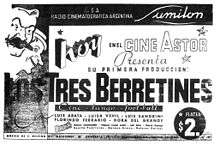Los tres berretines
Los tres berretines (The Three Whims) is a 1933 Argentine black and white comedy film, the first film made by the newly formed Lumiton film studio, and one of the first sound films made in Argentina. It was a great success and launched the film career of the comedian Luis Sandrini.
| Los tres berretines | |
|---|---|
 | |
| Directed by | John Alton, José Guerrico, László Kish, Luis Romero Carranza, Enrique Telémaco Susini |
| Produced by | Raúl Orzábal Quintana |
| Written by | Nicolás de las Llanderas, Arnaldo Malfatti |
| Starring | Luis Arata, Luis Sandrini, Luisa Vehil |
| Music by | Enrique Delfino "Delfy" |
| Cinematography | John Alton |
| Edited by | Francisco Múgica |
Production company | |
Release date |
|
Running time | 65 minutes |
| Country | Argentina |
| Language | Spanish |
Production
Los tres berretines was directed by Enrique Telémaco Susini and starring the local actors Luis Sandrini and Luisa Vehil.[1][2] The American cinematographer John Alton was not credited but may have played an important role in direction and cinematography.[3] Los tres berretines was based on a hit play of the same name, in which the circus performer and actor Luis Sandrini played Eusebio, a brother with a dream of becoming a famous tango composer. Lumiton expanded his role in the film version.[4] Los tres berretines was released on 19 May 1933 in the Ástor in Buenos Aires.[1] It was the second Argentine film with an optical soundtrack. The first was ¡Tango!, released the week before.[5]
Synopsis
The film has traditional popular melodrama plot elements, and includes performances of tango songs.[6] It depicts a family whose members are obsessed with the three national berretines (interests or hobbies) of tango, football and cinema.[7] (In the play the last berretín was radio.).[8] The family is middle class and makes its living from a hardware store. The father complains that the hobbies lead the family to neglect business. In the end, the father himself succumbs to all three hobbies.[8]
Reception
The film, which cost 18,000 pesos to produce, earned over one million.[1] Sandrini's performance made him the first local cinema star.[7]
Full cast
The full cast was:[9]
- Luis Arata
- Luis Sandrini
- Luisa Vehil
- Florindo Ferrario
- Benita Puértolas
- Héctor Quintanilla
- Malena Bravo
- Dolores Dardes
- Miguel Ángel Lauri
- Luis Díaz
- Dora del Grande
- Mario Danesi
- Homero Cárpena
- Mario Mario
- Trío Foccile
- Marafiotti
- Aníbal Troilo
- Miguel Leme
- Osvaldo Fresedo
- Leonor Rinaldi (uncredited)
References
Citations
- Martínez 2004.
- Rist 2014, p. 4.
- Rist 2014, p. 20.
- Karush 2012, p. 117-118.
- Rist 2014, p. 42.
- Karush & Chamosa 2010, p. 39.
- Creacion de Argentina Sono Film Y Lumiton, Cinematec.
- Mann 2011.
- The Three Amateurs, IMDb.
Sources
- "Creacion de Argentina Sono Film Y Lumiton". Historia del Cine Argentino. Cinematec. Retrieved 2014-06-02.
- Karush, Matthew B.; Chamosa, Oscar (2010-04-30). The New Cultural History of Peronism: Power and Identity in Mid-Twentieth-Century Argentina. Duke University Press. ISBN 0-8223-9286-0.CS1 maint: ref=harv (link)
- Karush, Matthew B. (2012-05-15). Culture of Class: Radio and Cinema in the Making of a Divided Argentina, 1920–1946. Duke University Press. p. 74. ISBN 0-8223-5264-8. Retrieved 2014-06-02.CS1 maint: ref=harv (link)
- Mann, Ester (26 July 2011). "Cine Argentino: Los tres berretines". Artesanias Literarias (in Spanish). Retrieved 2014-06-02.CS1 maint: ref=harv (link)
- Martínez, Adolfo C. (1 August 2004). "Lumiton renace en un museo". La Nacion (in Spanish). Retrieved 2014-06-01.CS1 maint: ref=harv (link)
- Rist, Peter H. (2014-05-08). Historical Dictionary of South American Cinema. Rowman & Littlefield Publishers. ISBN 978-0-8108-8036-8. Retrieved 2014-06-01.CS1 maint: ref=harv (link)
- "The Three Amateurs". IMDb. Retrieved 2014-06-02.